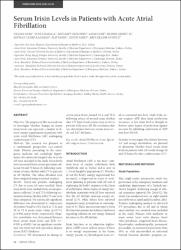Serum irisin levels in patients with acute atrial fibrillation

Göster/
Erişim
info:eu-repo/semantics/openAccessTarih
2019Yazar
Özer, VildanKaraca, Yunus
Günaydın, Mücahit
Özer, Savaş
Şahin, Mürsel
Karahan, Süleyman Caner
Gündüz, Abdulkadir
Üst veri
Tüm öğe kaydını gösterKünye
Özer, V., Karaca, Y., Günaydın, M., Özer, S., Şahin, M., Karahan, S.C., Şahin, E., Şahin, A. & Gündüz, A. (2019). Serum Irisin Levels in Patients with Acute Atrial Fibrillation. Signa Vitae, 15(2), 34-38. https://doi.org/10.22514/SV152.092019.5Özet
Objective: the purpose of this research was to investigate whether changes in serum irisin levels can represent a marker of altered energy requirements in patients with acute atrial fibrillation (AF) undergoing cardioversion (CV). Methods: the research was planned as a randomized, prospective case-control study. Patients presenting to the emergency medicine and cardiology departments of a university hospital due to acute AF were included in the study. Irisin levels were measured from serum specimens collected 24 and 72 hours (h) following restoration of sinus rhythm with CV in patients in AF rhythm. the values obtained were then compared using statistical analysis. Results: Thirty-one patients undergoing CV due to acute AF were enrolled. Mean irisin levels were studied from serum specimens collected 24 and 72 h following restoration of sinus rhythm with CV, and were then compared. No statistically significant difference was determined at comparison of patients' basal to 24 h, basal to 72 h, and 24 to 72 h mean irisin values (p0.734, p0.958, and p0.643, respectively). Negative correlation was determined between basal serum irisin levels and LDL (r= -0.519, p= 0.002), but no significant correlation was observed with epicardial adipose tissue (EAT) thickness. Conclusion: We determined no change in serum irisin levels studied 24 h and 72 h following return of normal sinus rhythm after CV from basal serum irisin levels in patients with acute AF. No correlation also was determined between serum irisin levels and EAT thickness.

















